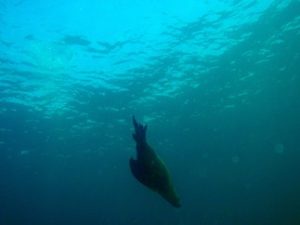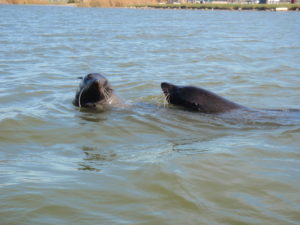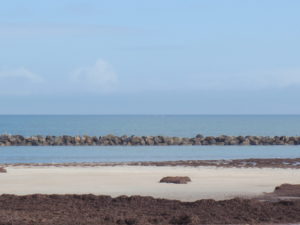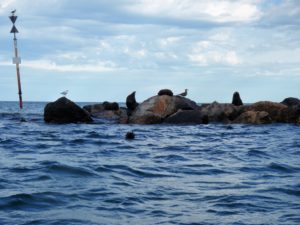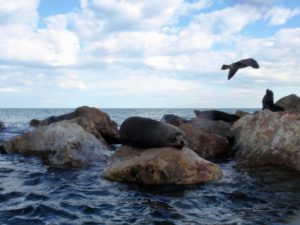Thanks to Dr Mike Bossley, we now have an electronic copy of the paper titled “Fur seals and sea lions (family Otariidae) on the breakwaters at Adelaide’s Outer Harbor, South Australia” co-written by Peter D. Shaughnessy, Mike Bossley and A. O. Nicholls (CSIRO PUBLISHING Australian Mammalogy, 2018, 40, 157–161 https://doi.org/10.1071/AM17001 ).
Outer Harbor’s southern breakwater
According to the paper’s abstract, “Long-nosed fur seals (Arctocephalus forsteri) and Australian sea lions (Neophoca cinerea) on the breakwaters at the mouth of the Port River estuary at Adelaide’s Outer Harbor were counted from 2004 to 2015. Observed counts were modelled using a generalised linear model. Fur seal numbers have been increasing since 2011; for sea lions there was a small discernible annual trend in counts. Counts of fur seals varied seasonally; most annual maxima were in August or September with modelled peak numbers around 9–11 September. The maximum count of fur seals was 79 in September 2015. For sealions, the model predicts annual peaks in the period 28 August to19 September. The maximum count of sealions was nine in September 2009. The haulout sites on the Outer Harbor breakwaters are easily accessible by boats, including pleasure craft. In particular, the seaward end of the outer breakwater is a popular spot with recreational anglers whose lines are often within a few metres of the seals. We propose that a management plan should be developed involving a study of the effect of boat approaches on seals utilising the Outer Harbor area followed by education coupled with enforcement.”
Close-up of southern breakwater
The paper states that people frequently ignore the approach limit of 50m* set by the South Australian Department of Environment, Water and Natural Resources for seals and sealions. It also states that it will be important to ensure that seals using the Outer Harbor breakwaters are protected from disturbance in the near future.
Northern or Outer breakwater
The paper concludes with comments that a management plan should be developed specific to seals utilising the Outer Harbor area. It suggests that the first step should be a study of the effect on seals using the breakwaters of approaching boats to determine the appropriate width of a buffer zone. It says that that should be followed by a management regime involving education coupled with enforcement. It suggests that “rangers of the Adelaide Dolphin Sanctuary could improve education of boaters about approach distances by distributing pertinent educational material at boat ramps and, while on water patrols, to boaters at the breakwaters” and “Signage on the breakwaters could also assist, and that would require consultation between managers of the breakwaters (Department of Planning, Transport and Infrastructure) and managers of the seals (Department of Environment, Water and Natural Resources**)”.
A seal descending from the surface
* (According to the web page found at https://www.environment.sa.gov.au/managing-natural-resources/plants-and-animals/Living_with_wildlife/seals/frequently-asked-questions , “People should not approach fur seals. They are large, powerful animals and like any wild animal, they can react aggressively if they feel threatened. If they are left alone, they do not usually pose a threat to humans. We should always keep our distance from any marine mammal, but this is more for their protection than ours. On land, seals are at risk of being attacked by dogs, and in the sea, they may be hit by boats. Do not get closer than 30 m to a seal if it is on land. In the water, prescribed vessels like jet skis and ski boats must stay 300 m away from seals, while motorised vessels, sail boats and kayaks should not get any closer than 50 m. Swimmers should stay at least 30 m away. When a seal is on shore, people should not get between it and the water because the seal could become frightened and flee to the water whether or not there is a person in the way.”)
** (Now Department of Environment and Water)
New Zealand Fur Seals
Mike Bossley reports counting 48 seals on the northern/outer breakwater at Outer Harbor on 1st August 2018. I saw at least nine seals on the Semaphore South breakwater during my brief kayak there on 23rd July. My landlord tells me that there are often as many as 15 seals there at any one time.
Semaphore South breakwater
I was encouraged to visit the site after receiving this message from Simon Vickers: –
“Hi MLSSA, I am a Semaphore resident and I love these seals.
I currently work at sea as a Cruise Ship Director but am returning home soon and i want to get in touch with anyone wanting to run a study on these seals.
Seals at Semaphore South breakwater
Also looking at funding it with a tourism venture- swim with seals, etc… after an incredible encounter with the seals and a small pod of 5 dolphins last summer. My friends and i were out kayaking and I took them to see the seals. We paddle up and then raft together the kayaks watching the seals thermo-regulate. they then went fishing for their lunch just in front of us before being joined by first 2 dolphins and then 3 more.
I want to safe guard the seals and also raise awareness of them and how to act around them. Can you help by pointing me in the right direction?
Many thanks, Simon Vickers”
Seals on the Semaphore South breakwater
Simon later told us, “I’m putting together a plan with three sequential objectives.
1- raise awareness and educate about them.
2-ensure their preservation and encourage research
3- create viable tourist attraction with portion of funds aside to achieve objectives 1 and 2
It’s only at the planning stage but I’m positive it has potential. Many thanks, Simon”
The seals are turning out to be as big an attraction in the Port Adelaide area as the local dolphins, it seems.
(All photos by Steve Reynolds)
P.S. I’ve just realised that Dan Monceaux wrote about the Semaphore South breakwater in his article titled Long-nosed Fur Seals at the Fort Glanville Breakwater





